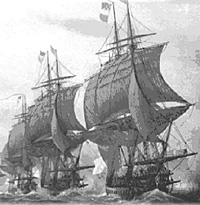 1740. Somewhere off Brest, France. Does the Royal Navy truly rule the seas? The French challenged this notion and paid dearly after a close fought battle that tipped back and forth through 18 turns. The British with superior crews were out gunned in numbers, but used superior tactics to hammer the French into withdrawal. The British squadron began with the wind to its back while the French had to beat against it to narrow the distance. The British, depending upon their superior crew training, opened fire at medium range and quickly scored several hits on the leading French 74 gun SOL. Unfortunately for the French, the British were able to form line of battle and fire repeatedly while most of the French ships were blocked by their own vanguard. By the time the French 104 narrowed the distance and fired its first broadside with telling effect, it had already received damage from British longrange fire. Shortly afterwards, the leading French 74 struck its colors in a desperate effort to stay afloat. The second French 74 survived a British boarding effort and fought its way clear of the battle heavily damaged.
1740. Somewhere off Brest, France. Does the Royal Navy truly rule the seas? The French challenged this notion and paid dearly after a close fought battle that tipped back and forth through 18 turns. The British with superior crews were out gunned in numbers, but used superior tactics to hammer the French into withdrawal. The British squadron began with the wind to its back while the French had to beat against it to narrow the distance. The British, depending upon their superior crew training, opened fire at medium range and quickly scored several hits on the leading French 74 gun SOL. Unfortunately for the French, the British were able to form line of battle and fire repeatedly while most of the French ships were blocked by their own vanguard. By the time the French 104 narrowed the distance and fired its first broadside with telling effect, it had already received damage from British longrange fire. Shortly afterwards, the leading French 74 struck its colors in a desperate effort to stay afloat. The second French 74 survived a British boarding effort and fought its way clear of the battle heavily damaged.
Not so lucky was the second 74 in the British line. Struck repeatedly by the 104, it capsized and sank with all hands. At that point, fortune seemed to favor the French as several British ships fouled one another in a series of collisions that momentarily left them vulnerable. However, the French were unable to take advantage of the collisions. Fire reached the powder magazine on the French 104, and it blew up with devastating effect on two nearby British 74's. A second French 74, pounded by superior British gunnery also stuck and was seized by British boarding parties. The two French 74's arriving late on the scene were unable to intervene and fled in pursuit of their battered cousin.
Losses:
French: one 104 gun SOL blown up, two 74 gun SOLs struck and heavily damaged, one 74 gun SOL heavy damage
British: one 74 gun SOL sunk, three 74 gun SOLs heavily damaged, one 74 gun SOL moderate damage
Rules: Wooden Ships and Iron Men (basic plus some advanced rules)
Scale: 1/2400 sailing ships
Forces:
French: one 104 gun ship of the line (SOL) with Average (AVG) crew and four 74 gun SOLs with AVG crews
British: two 74 gun SOLs with Crack crews and two 74 gun SOLs with AVG crews
French Reinforcements (arriving turn 3): two 74 gun SOLs with Green crews
British Reinforcements (arriving trun 5): one 74 gun SOL with AVG crew
Analysis
The French began with the wind against them and never formed a proper line of battle that allowed unobstructed fire. End result--usually three British ships fired to one French ship. Even when the wind changed in their favor, the French could not take advantage of it fast enough. The French clearly outgunned the British, but were never able to use that superiority to their advantage. Crew superiority clearly aided the British, but even so, it was a very close call. The French attempted to close before firing their initial broadsides, thus taking a pounding as they narrowed the range. Had the French 104 not blown up shortly after finishing off its first victim, it might have made the difference. Its destruction demoralized what was left of the French line. The two French 74s arriving late on the scene did some damage, but could not finish off the British cripples without support. Still, it was very close. Three of the four surviving British 74's lacked only a few hull hits of striking or sinking. Had the French 104 lasted a few turns more, the Royal Navy would have lost more ships and possibly the battle. As it fell out, the Royal Navy won a narrow victory. Britannia rules the waves!
Back to Dispatch January 2005 Table of Contents
Back to Dispatch List of Issues
Back to MagWeb Master Magazine List
© Copyright 2005 by HMGS Mid-South
This article appears in MagWeb.com (Magazine Web) on the Internet World Wide Web. Other articles from military history and related magazines are available at http://www.magweb.com